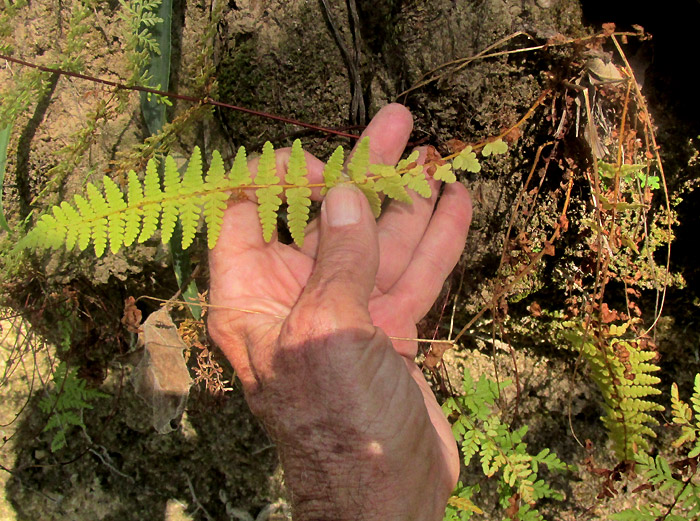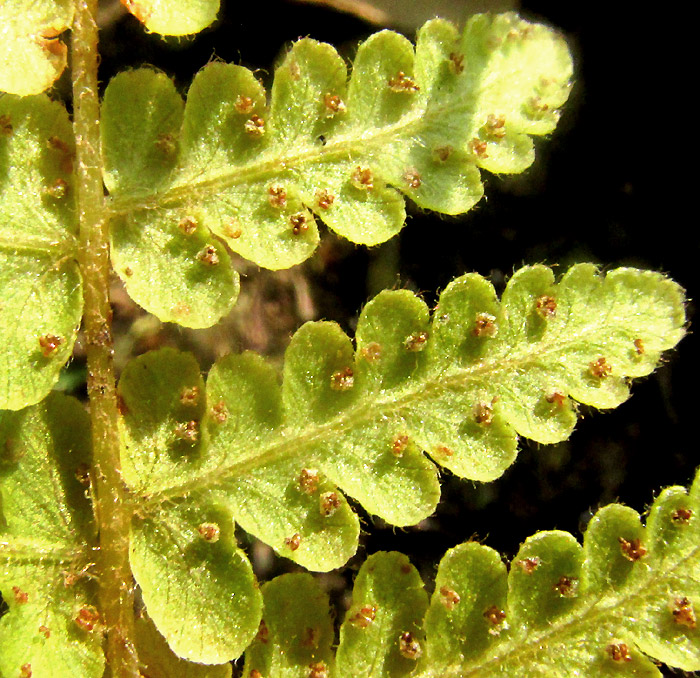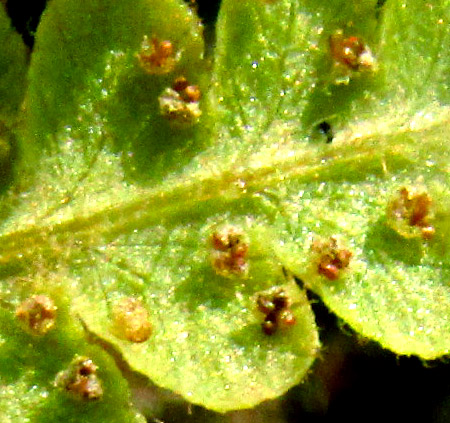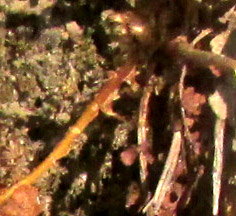Excerpts from Jim Conrad's
Naturalist Newsletter
Entry dated November 7, 2023, from notes taken near Cascadas de La Piedad waterfall 3kms NW of the community of San Pablo, municipality of Almeaco de Bonfil; bedrock of thick layers of compacted volcanic ash, or tuff; N20.1024°, W100.0019°, elevation 2360 meters (7750ft); extreme southern Querétaro state, MÉXICO
WOODSIA MOLLIS

The above fern clung to a vertical wall of compacted volcanic ash, in a washout of a gully eroding into an oak forest on a steep slope. The fern's general form was similar to that of several other locally found species producing once-pinnately divided blades with deeply lobed pinnae, and likely to inhabit such a habitat -- for example the Bonaire Lipfern. However, close-up, our fern revealed its own distinctive details:

Both surfaces of the pinnea bore a thin covering of short, slender hairs, or cilia, and larger hairs and scales appeared on the blade's midrib, or stipe. Pinna lobe tips were broadly and regularly rounded. The most determinative feature was the nature of the rounded, spore-producing sori appearing on the pinnae's lower surfaces. Each grainy looking, light brown sorus was surrounded by a white, papery, bowl-like indusium, which usually was fractured into scale-like parts. Most indusia, when present at all, arise on one side of its sorus, not all around the base, and sori appear in many shapes other than round.

Closer seen at the right, the round sori, each surrounded by an indusium arising at its base, provide the main field mark for species belonging to the worldwide-occurring Woodsia Family, the Woodsiaceae. Helpful for identifying this particular species is that the base of its stipes often bear conspicuous but sparsely scattered, triangular, papery scales, as shown below:

As of 2023, the Woodsia family may incorporate only one genus, Woodsia, while many would say that certain Woodsia species should be split from the genus to form one or two other Woodsia Family genera. Also, some experts regard the whole Woodsia Family as just a section of the Spleenwort Family, the Aspleniaceae. Whichever family our gully bank fern belongs to, currently it's recognized as a genuine Woodsia. In 2023, Kew's Plants of the World Online database accepts 53 Woodsia species worldwide, though that counts species which many would assign to the genus, Physematium.
In our part of upland central Mexico two, maybe three or even four Woodsia species have been documented. Our fern with its broadly and evenly rounded pinnae tips and its general hairiness, and large scales on the stipes' bases, works out to be the Woodsia species by far the most frequently encountered in this region, WOODSIA MOLLIS. It bears no English name, though all Woodsia species may be referred to as cliff ferns.
Woodsia mollis occurs on woody, rocky slopes in Mexico's uplands from the northern states south into the Nicaraguan mountains. On rocky slopes, it can be fairly common.
I find no literature referring to human use of Woodsia mollis, though other Woodsia species have been documented as used in traditional medicine. For instance, in Mongolia Woodsia ilvensis is used to treat diarrhea, abdominal pain, and soft-tissue injuries in humans, and internal injuries and open wounds on livestock.
Our Woodsia mollis was serving all living things not only by photosynthesizing oxygen and recyclable organic matter into existence, but also by stabilizing with its roots the dirt of the vertical gully face it occupied, retarding erosion.